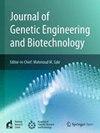花生(arachhis hypogaea L.)根系构型在促进可持续农业和抗灾作物生产中对气候变化的适应作用的研究进展
IF 2.8
Q3 Biochemistry, Genetics and Molecular Biology
Journal of Genetic Engineering and Biotechnology
Pub Date : 2025-07-11
DOI:10.1016/j.jgeb.2025.100535
引用次数: 0
摘要
花生(arachhis hypogaea L.)种植越来越容易受到气候变化的影响,干旱和热胁迫正成为影响生产力和粮食安全的主要制约因素。本文探讨了根系构型在提高花生对环境胁迫的适应性中的重要作用,并从遗传、生理和农艺等方面评价了目前改善根系性状的策略和未来发展方向。在干旱条件下,根深、木质部结构优化的高效根系能显著改善水分和养分的获取。关键的调控因子,如脱落酸(ABA)、独角酯内酯和特定的根相关基因调节根的发育和胁迫反应。根系分泌物进一步增强了土壤根系的相互作用,而花生根系微生物群有助于养分循环和恢复力。生物技术工具,包括数量性状位点(QTL)定位和基于CRISPR/ cas的基因组编辑,正在被用来在分子水平上操纵根性状。农艺实践,如覆盖和覆盖种植,通过加强土壤结构和保持水分,与遗传改良协同作用。通过整合现代育种、生物技术进步和可持续土壤管理来加强花生根系结构,为实现气候适应型花生生产提供了一条有希望的道路。未来的研究应该优先考虑这些方法的融合,以及微生物组的探索,以确保产量稳定和气候变化中的粮食安全。本文章由计算机程序翻译,如有差异,请以英文原文为准。

Exploring the role of Peanut (Arachis hypogaea L.) root architecture in enhancing adaptation to climate change for sustainable agriculture and resilient crop production: A review
Peanut (Arachis hypogaea L.) cultivation is increasingly vulnerable to climate change, with drought and heat stress emerging as major constraints to productivity and food security. This review explores the critical role of root architecture in enhancing peanut adaptation to environmental stressors, and evaluates current strategies and future directions for improving root traits through genetic, physiological, and agronomic approaches. Efficient root systems, characterized by deeper rooting and optimized xylem design, significantly improve water and nutrient acquisition under drought conditions. Key regulators such as abscisic acid (ABA), strigolactones, and specific root-related genes modulate root development and stress responses. Root exudates further enhance soil root interactions, while the peanut root microbiome contributes to nutrient cycling and resilience. Biotechnological tools, including quantitative trait loci (QTL) mapping and CRISPR/Cas-based genome editing, are being harnessed to manipulate root traits at the molecular level. Agronomic practices like mulching and cover cropping synergize with genetic improvements by enhancing soil structure and moisture retention. Strengthening peanut root architecture through the integration of modern breeding, biotechnological advances, and sustainable soil management offers a promising path toward climate-resilient peanut production. Future research should prioritize the convergence of these approaches, alongside microbiome exploration, to secure yield stability and food security in a changing climate.
求助全文
通过发布文献求助,成功后即可免费获取论文全文。
去求助
来源期刊

Journal of Genetic Engineering and Biotechnology
Biochemistry, Genetics and Molecular Biology-Biotechnology
CiteScore
5.70
自引率
5.70%
发文量
159
审稿时长
16 weeks
期刊介绍:
Journal of genetic engineering and biotechnology is devoted to rapid publication of full-length research papers that leads to significant contribution in advancing knowledge in genetic engineering and biotechnology and provide novel perspectives in this research area. JGEB includes all major themes related to genetic engineering and recombinant DNA. The area of interest of JGEB includes but not restricted to: •Plant genetics •Animal genetics •Bacterial enzymes •Agricultural Biotechnology, •Biochemistry, •Biophysics, •Bioinformatics, •Environmental Biotechnology, •Industrial Biotechnology, •Microbial biotechnology, •Medical Biotechnology, •Bioenergy, Biosafety, •Biosecurity, •Bioethics, •GMOS, •Genomic, •Proteomic JGEB accepts
 求助内容:
求助内容: 应助结果提醒方式:
应助结果提醒方式:


